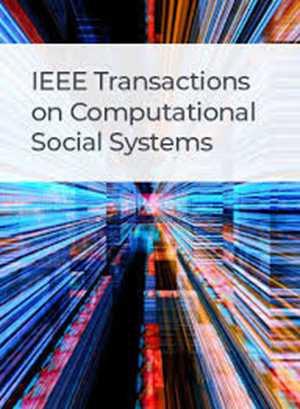面向推荐系统的上下文语义交互图嵌入式学习
IF 4.5
2区 计算机科学
Q1 COMPUTER SCIENCE, CYBERNETICS
IEEE Transactions on Computational Social Systems
Pub Date : 2024-06-05
DOI:10.1109/TCSS.2024.3394701
引用次数: 0
摘要
推荐系统已成为当今数字时代不可或缺的工具,通过根据个人喜好策划个性化的项目推荐,大大提高了用户在各种在线平台上的参与度。长期以来,协同过滤技术一直占据着该领域的主导地位,它主要利用用户与物品之间的交互数据,但往往无法囊括这些交互所固有的丰富而错综复杂的上下文和不断变化的动态。认识到这一局限性后,我们的研究引入了上下文语义交互图嵌入(CSI-GE)方法。这种先进的模型在多层图卷积网络中加入了动态跳转窗口,确保全面提取即时和不断变化的上下文特征。通过融合自监督对比学习,我们实现了用户和项目嵌入的细化。此外,我们创新的基于方差-方差-协方差(VIC)正则化的损失函数加强了这些嵌入的鲁棒性。通过严格的测试,CSI-GE 的性能始终优于同类方法,突出了其卓越的准确性和稳定性。本文章由计算机程序翻译,如有差异,请以英文原文为准。
Contextual Semantics Interaction Graph Embedding Learning for Recommender Systems
Recommender systems have become an indispensable tool in today's digital age, significantly enhancing user engagement on various online platforms by curating personalized item recommendations tailored to individual preferences. While the field has long been dominated by the collaborative filtering technique, which primarily leverages user–item interaction data, it often falls short in encapsulating the rich contextual intricacies and evolving dynamics inherent to these interactions. Recognizing this limitation, our research introduces the contextual semantic interaction graph embedding (CSI-GE) method. This advanced model incorporates a dynamic hop window within a multilayer graph convolutional network, ensuring a comprehensive extraction of both immediate and evolving contextual features. By amalgamating self-supervised contrastive learning, we achieve a refinement of user and item embeddings. Furthermore, our innovative variance–invariance–covariance (VIC) regularization-based loss function fortifies the robustness of these embeddings. Through rigorous testing, CSI-GE consistently outperformed contemporary methods, underscoring its superior accuracy and stability.
求助全文
通过发布文献求助,成功后即可免费获取论文全文。
去求助
来源期刊

IEEE Transactions on Computational Social Systems
Social Sciences-Social Sciences (miscellaneous)
CiteScore
10.00
自引率
20.00%
发文量
316
期刊介绍:
IEEE Transactions on Computational Social Systems focuses on such topics as modeling, simulation, analysis and understanding of social systems from the quantitative and/or computational perspective. "Systems" include man-man, man-machine and machine-machine organizations and adversarial situations as well as social media structures and their dynamics. More specifically, the proposed transactions publishes articles on modeling the dynamics of social systems, methodologies for incorporating and representing socio-cultural and behavioral aspects in computational modeling, analysis of social system behavior and structure, and paradigms for social systems modeling and simulation. The journal also features articles on social network dynamics, social intelligence and cognition, social systems design and architectures, socio-cultural modeling and representation, and computational behavior modeling, and their applications.
 求助内容:
求助内容: 应助结果提醒方式:
应助结果提醒方式:


